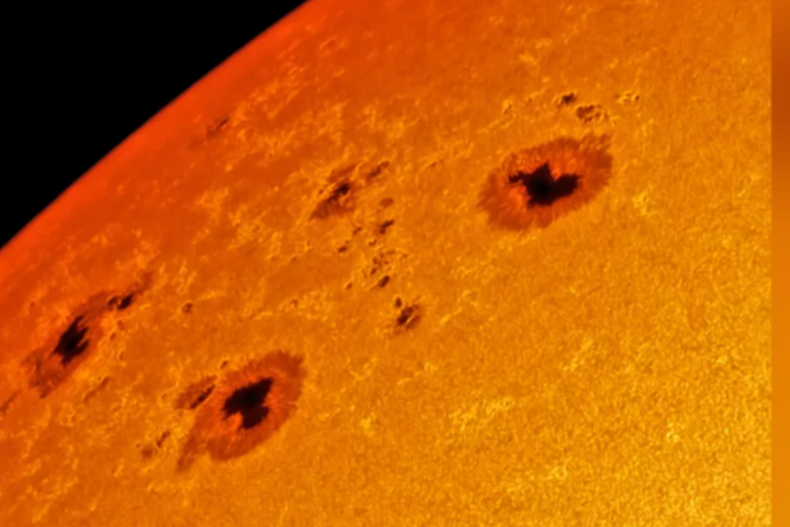Two massive swarms of sunspots have just appeared on the sun’s surface, indicating a greater likelihood of spectacular auroras and possibly dangerous solar flares in the months to come in the solar system. Some of the sunspots are so massive that they have the potential to devour the whole planet.
They are referred to as “active regions” 2993 and 294 (AR2993 and AR2994), respectively. The new sunspot groups appear to be followed by a third sunspot group, which is still hidden behind the sun’s northeastern limb (or apparent edge), and which appears to have caused a powerful solar flare that narrowly missed the Earth just a few days ago.
Each swarm is made up of numerous sunspots and spans an area hundreds of millions of square miles in size, which is much greater than the Earth’s circumference. Their formation is triggered by magnetic disturbances in the visible photosphere of the sun, which expose the considerably colder layers underneath the visible photosphere.
The sun’s magnetic entanglements and disentanglements occur in 11-year cycles, with each solar cycle including periods of low and high activity. Since the beginning of significant tracking of sunspot activity in 1775, solar activity cycles have been numbered. We are presently in Solar Cycle 25, which has not yet reached its apex, indicating that there will be even more sunspot activity in the future.
If you look at the sun, “I’m sure we’ll see bigger active regions over the next few years,” Dean Pesnell of NASA’s Goddard Space Flight Center said in an email to Live Science. “Active areas 2993 and 2994 are of average size, and they do not reflect the best that Solar Cycle 25 has to offer.”
According to Pesnell, the current cycle is likely to reach its peak activity in late 2024 or early 2025. Energy from the active areas may be discharged in the form of radiation (solar flares) and coronal mass ejections (CMEs), which are super-hot balls of plasma.
Solar flares and coronal mass ejections (CMEs) may produce beautiful auroras, but they can also pose a threat to power grids, satellites, communications networks, and even space travelers who are travelling beyond the safety of the Earth’s magnetic field.
The massive X1.1 class solar flare detected on Sunday (April 17) now seems to be from a third active region of sunspots that’s rotating onto the sun’s visible disk behind the other two.
SOLAR CYCLE 25
During an interview with Live Science, Jan Janssens, a communications expert at the Solar-Terrestrial Center of Excellence in Brussels, said that the sun has already been quite active over the previous several weeks and that there is no indication that it will become less active any time soon.
Just this week, the Earth barely avoided an ejection of solar plasma associated to a much earlier sunspot group, which may have caused a solar storm.
“This is a common occurrence at this period of the solar cycle,” Janssens said during an email response. “As the solar cycle nears its apex, larger and more complex sunspot patches become apparent, which may then create solar flares,” says the National Solar Observatory.
In addition, records reveal that the present level of solar activity is around the same as it was during the last solar cycle and sometimes even below than it was at this time throughout the two solar activity cycles before that, according to Mr. Sargent.
P.J. Pesnell, the NASA Solar Dynamics Observatory project scientist, said a powerful class X1.1 flare detected on Sunday (April 17) now appears to have originated in the sunspot group AR2993, which is rotating behind AR2994 onto the visible disc of the sun, and that it was likely caused by the group.
According to NASA, scientists split solar flares into five classes, each of which is ten times more intense than the previous one – A, B, C, M, and X. In each category, there are nine divisions, and the most powerful X-class flares can contain more than ten times the power of an X1 flare, so theoretically there is no limit to how big they can get – the most powerful flare ever recorded, in 2003, overwhelmed the sensors at X28. Each category has nine divisions.
SOLAR FLARES
An X-ray pulse from Sunday’s X1 flare, according to the National Oceanic and Atmospheric Administration (NOAA), caused a widespread radio blackout throughout Southeast Asia and Australia at frequencies below 30 MHz.
However, it has also established that the coronal mass ejection (CME) of star material from the most recent solar flare would avoid Earth.
When CMEs do make contact with the Earth, however, they may have devastating consequences, such as overloading electrical networks or radio communications, or even injuring astronauts in orbit. They may also inflict direct damage to satellite electronics, as well as heat the gases in the upper atmosphere, which increases the drag on satellites in low orbits due to increased drag.
The frequency of solar flares and coronal mass ejections is expected to increase over the next several years, according to Pesnell, enhancing the degree of solar activity’s threat.
For the time being, the contemporary world seems to have escaped the worst consequences of solar storms, and power-grid operators are already taking steps to “harden” their technology in order to prevent such interruptions from occurring.
However, during the “Halloween storms” of 2003, most of the worst solar flares in recent memory knocked out the power in portions of Europe and South Africa for many hours, causing widespread blackouts.
Edited By: Vanshika Sahu
Published By: Mohammed Anees













